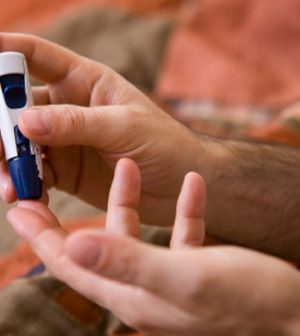- Navigating Your Midlife Crisis: Embracing New Possibilities
- City Raccoons Showing Signs of Domestication
- Mapping the Exposome: Science Broadens Focus to Environmental Disease Triggers
- One Week Less on Social Media Linked to Better Mental Health
- Your Brain Changes in Stages as You Age, Study Finds
- Some Suicide Victims Show No Typical Warning Signs, Study Finds
- ByHeart Formula Faces Lawsuits After Babies Sickened With Botulism
- Switch to Vegan Diet Could Cut Your Greenhouse Gas Emissions in Half
- Regular Bedtime Does Wonders for Blood Pressure
- Dining Alone Could Mean Worse Nutrition for Seniors
Goodbye, Needles? Patch Might Be the Future for Blood-Sugar Tracking

Developers of a new patch hope to eliminate a big barrier in type 2 diabetes treatment — painful finger-sticks and injections.
The new patch — which actually uses an array of tiny needles that researchers promise are pain-free — senses when blood sugar levels are rising and then releases medication to bring those elevated levels back down.
That means the patch could end the need to draw blood from your fingertips to check your blood sugar level. It could also eliminate the needles used to administer insulin or other diabetes medications.
“This type of disposable patch is expected to control blood glucose levels for a week,” said the study’s senior author, Xiaoyuan (Shawn) Chen, chief of the laboratory of molecular imaging and nanomedicine at the U.S. National Institute of Biomedical Imaging and Bioengineering in Bethesda, Md.
“It will not complicate the routines of daily living,” Chen said.
Though the patch looks promising, so far it’s been tested only on 21 mice with type 2 diabetes. Results from animal trials aren’t always equaled in human trials.
The patch contains chemicals that sense rising blood sugar levels. When that happens, a medication called exendin-4 is released to trigger the body to produce insulin until blood sugar levels start to fall.
Exendin-4 is part of a class of drugs called GLP-1 receptor agonists. It’s currently on the market in the United States as Byetta, a twice-daily injection. Other drugs in this class of injectable medications include Trulicity and Bydureon, which are weekly injections, and Victoza, which is a daily injection, according to the American Diabetes Association.
For the patch, exendin-4 is combined with alginate, a gum-like material extracted from brown algae. This mixture is then poured into microneedle form and loaded onto the patch.
The patch tested on the mice was about a half-inch square, according to the researchers. It contained enough medication for a week.
“We achieved a smart, long-acting and glucose-responsive exendin-4 release,” Chen said.
He noted that some of the mice had inflammation at the site of the patch. In humans, nausea and vomiting are known side effects of the drug, but the researchers believe that the release of exendin-4 is slow enough that it won’t cause those side effects.
The next step is to make a larger patch with more needles, Chen explained. The researchers will also need to create longer needles to penetrate human skin.
Dr. Joel Zonszein, director of the Clinical Diabetes Center at Montefiore Medical Center in New York City, said it looked like the patch worked well in the study.
“But it’s a big stretch from mice to even trying something like this in humans and getting approved by the [U.S. Food and Drug Administration],” said Zonszein, who wasn’t involved with the study.
Still, he said, the patch itself is a very good idea, and the beauty of it would be that it wouldn’t require people with diabetes to spend a lot of time managing their disease.
However, Zonszein pointed out that oral versions of GLP-1 drugs are in clinical trials and will compete with injections in the not-far-off future.
Also, while the patch idea is interesting, “exendin-4 is the wrong medication,” Zonszein said. If researchers could figure out how to make the patch with insulin, he said, that would likely be a better option, though the required doses of insulin might be too large to fit in the patch.
Results of the researchers’ study on the patch treatment on mice were published online recently in Nature Communications.
More information
The American Diabetes Association has more on treating type 2 diabetes.
Source: HealthDay
Copyright © 2025 HealthDay. All rights reserved.










